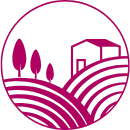Tasting French wines
If you’re a big fan of Bordeaux wine from Pessac-Léognan but don’t know why, or you love Pinot Noir and Chardonnay wines but thought they were exclusive to Burgundy, exploring French wine regions will help you better understand your favourites.
A wine holiday in France is the perfect way to dive deeper and discover new varieties by tasting them locally. The following overview by grape variety provides a starting point, but nothing beats a trip for on-site tastings to grasp the true character of each one.

Key grape varieties
Cabernet Sauvignon, grown in Bordeaux, the Loire Valley and Languedoc-Roussillon, produces wines with high tannins and acidity, deep colour and intense flavours, so it’s excellent for ageing.
Chardonnay is used in sparkling and white wines (in Burgundy, Champagne and Languedoc) for crisp and refreshing tastes, often with notes of citrus. When oak-aged, Chardonnay white wines can take on creamy textures with vanilla and butter flavours.
Chenin Blanc, from the Loire Valley, produces a versatile taste, ranging from dry to sweet, with high acidity, that gives its wines freshness and ageing potential.
Merlot,from Bordeaux, Languedoc and the South West, offers rounder tannins than Cabernet Sauvignon – with notes of plum, chocolate and cherry. Merlot adds a fruit-forward character to blends.
Pinot Noir, known for its finesse and subtlety, thrives in Burgundy, Champagne and Alsace, producing wine with lighter tannins and moderate acidity. It’s also used in sparkling wines produced in Champagne and Burgundy because it provides structure, body and depth. Pinot Meunier, another Champagne grape variety, adds a quality of softness with red berry flavours.
Riesling, known for its purity and balance of sweetness and acidity, produces refreshing wines in Alsace, ranging from dry to sweet. Unlike most other French regions, Alsace wines are labelled by grape variety.
Sauvignon Blanc, grown in the Loire Valley and Bordeaux, is known for its crisp, zesty character and aromatic, herbal profile, which can be dry, making it great with seafood or light dishes.
Syrah, grown in the Rhone Valley and Languedoc, produces rich and full-bodied wines with dark fruit flavours, often with smoky, meaty or herbal undertones. Mourvèdre contributes rich, savoury flavours with an earthy taste. Grenache wines tend to be medium-bodied, with soft warm characters, and are often blended with Syrah and Mourvèdre.
Now that you know a little more about grape varieties, here are a few tasting tips.

Tasting tips
When tasting wine, whether red, white or sparkling, it’s a good idea to follow a basic method to fully appreciate its qualities. Here’s a 5-step guide commonly used in tastings:
- Look: Observe the colour and opacity to get clues about the wine’s age and grape variety.
- Swirl: Gently swirl to release the wine’s aromas. Champagne should be swirled gently to preserve the bubbles.
- Smell: Take a deep sniff and try to identify the primary, secondary and tertiary aromas (fruit, spices, oak, etc.).
- Taste: Take a small sip and let the wine cover your palate, noting its balance of acidity, tannins, alcohol and flavours.
- Finish: Pay attention to the aftertaste (how long the flavours linger after swallowing). Wines with oak ageing may have a longer finish – a sign of quality. White and sparkling wines should have a clean, crisp finish.
Red wines typically have more tannins, so you may notice a drying sensation on the gums. White wines tend to be more about freshness and acidity, which makes them feel lighter and often more refreshing. Sparkling wines highlight effervescence and pronounced acidity, offering a unique sensory experience due to both the taste and the texture of the bubbles.



